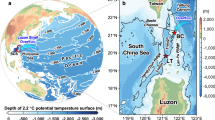Abstract
An attempt was made to reproduce the circulation pattern in Suo-Nada, Japan during spring and summer season in order to elucidate the water exchange mechanism in the basin. Two hydrographic surveys at the end of each season were conducted covering the entire Suo-Nada area. A three-dimensional hydrodynamic Princeton Ocean Model (POM) was used to compute the current resulting from the observed density and wind field. During spring, a very pronounced counter clockwise gyre is situated near the opening of the basin. This is replaced by a clockwise circulation which seemed to occupy the whole domain during summer. Within each season, however, the vertical distribution of current does not show any remarkable differences, indicating the dominance of horizontal current and a very weak estuarine flow. These observational and numerical results were used to estimate the remnant function and the corresponding average residence time of permanently dissolved matter (PDM) and transformable matter (TM). The results revealed a small difference in the average residence times of materials within each season but a large seasonal variability between spring and summer. Furthermore, calculations based on climatological density fields have indicated a similar trend of variation between the seasonal values of average residence times.
Similar content being viewed by others
References
Balotro, R. S., S. Ishijima and M. A. Estoque (1994): A numerical simulation of wind and tide-induced circulation for the Gulf of Lingayen, Philippines. Bulletin of the College of Science, University of the Ryukyus, 58, 51–74.
Blumberg, A. F. and G. L. Mellor (1987): A description of a three-dimensional coastal ocean circulation model. p. 1–16. In Three-Dimensional Coastal Ocean Models, Coastal and Estuarine Sciences, 4, ed. by N. S. Heaps, AGU, Washington, D.C.
Galperin, B. and G. L. Mellor (1990): A time-dependent, threedimensional model of the Delaware Bay and River System. Part 1: Description of the model and tidal analysis. Estuar., Coast. Shelf Sci., 31, 231–253.
Kamizono, M., PM. Yoshida, M. Ishida and T. Miita (1991): Surface current investigation in Suo-Nada using drift bottles. Bull. Coast. Oceanogr., 29, 97–103 (in Japanese with English abstract).
Korotenko, K. A. and R. M. Mamedov (2000): Modeling the process of the temperature anomaly formation in the coastal zone of the Caspian Sea. Oceanology, 4, 465–473.
Legovic, T. (1982): Water exchange between a coastal basin and the adjacent sea, with an application to Rijeka Bay. Deep-Sea Res., 29(8A), 999–1012.
Mellor, G. L. and T. Yamada (1982): Development of a turbulence closure model for geophysical fluid problems. Rev. Geophys. Space Phys., 20, 851–875.
Okaichi, T. and T. Yanagi (eds.) (1997): Sustainable Development in the Seto Inland Sea, Japan; From the Viewpoint of Fisheries. Terra Scientific Publishing Company, Tokyo, 329 pp.
Sarmiento, J. L. and K. Bryan (1982): An ocean transport model for the North Atlantic. J. Geophys. Res., 87, 394–408.
Senjyu, T., H. Yasuda, S. Sugihara and M. Kamizono (2001): Current and turbidity variations in the western part of Suo-Nada, the Seto Inland Sea, Japan: A hypothesis on the oxygen-deficient water mass formation. J. Oceanogr., 57, 15–27.
Takeoka, H. (1984): Fundamental concepts of exchange and transport time scales in a costal sea. Cont. Shelf Res., 3, 311–326.
Takeoka, H. and T. Hashimoto (1988): Average residence time of matter in coastal waters in a transport system including biochemical processes. Cont. Shelf Res., 8, 1247–1256.
Tawara, S. (1986): Studies on the characteristic of oceanographic condition in relation to fishing condition in the shallow coastal waters. The Journal of Shimonoseki University of Fisheries, 34(1), 1–103.
Yanagi, T. and S. Igawa (1992): Diagnostic numerical model of residual flow in the coastal sea—an example of adaption to Suo-Nada and Iyo-Nada—. Bull. Coast. Oceanogr., 30, 12–19 (in Japanese with English abstract).
Yanagi, T. and S. Takahashi (1988): Response to fresh water discharge in Osaka Bay. Umi to Sora (Sea and Sky), 64, 63–70 (in Japanese with English abstract).
Author information
Authors and Affiliations
Rights and permissions
About this article
Cite this article
Balotro, R.S., Isobe, A., Shimizu, M. et al. Circulation and Material Transport in Suo-Nada during Spring and Summer. Journal of Oceanography 58, 759–773 (2002). https://doi.org/10.1023/A:1022858710221
Issue Date:
DOI: https://doi.org/10.1023/A:1022858710221




